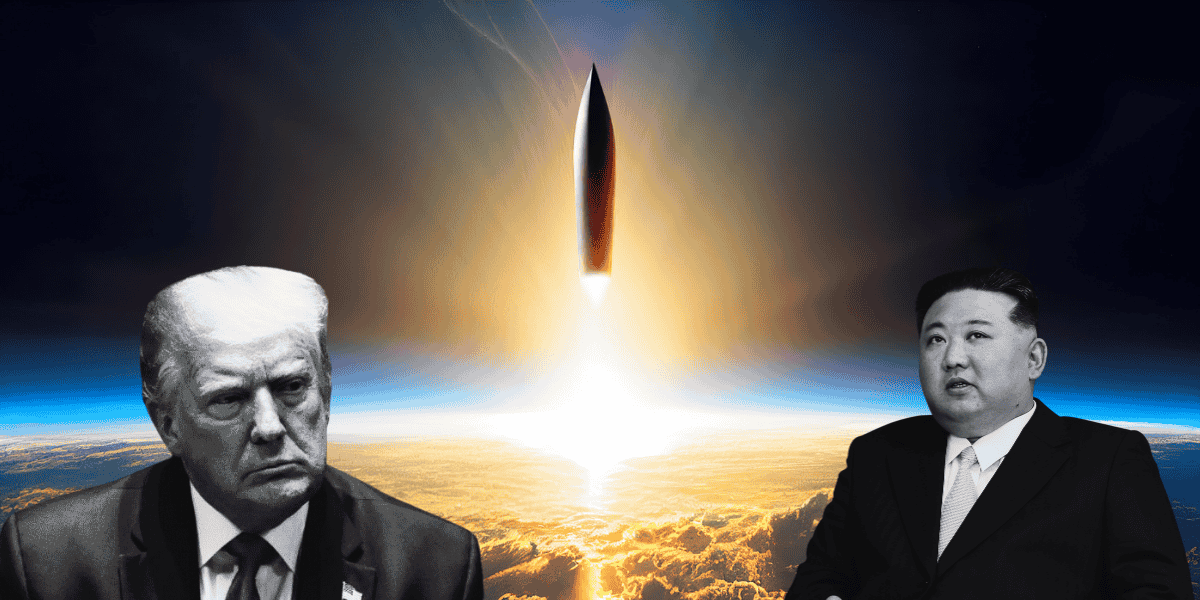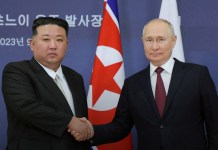Though President-elect Donald Trump remains committed to continuing the Biden Administration’s policy of attaching high priority to peace and stability in the Indo-Pacific, of all the US allies and friends in the region, the Republic of Korea (South Korea) seems most worried and nervous about his return to office.
And that is because of Trump’s “love affair,” though a failed one, with Communist North Korea, particularly its supremo Kim Jong Un, during his first term as the President.
Though not officially confirmed by Trump’s transition team, a report by Reuters says two team members have revealed that the team is discussing “pursuing direct talks with North Korean leader Kim Jong Un, hoping a fresh diplomatic push can lower the risks of armed conflict” in the Korean peninsula.
It may be noted that during 2017-2021, President Trump held three meetings with Kim in Singapore, Hanoi, and the Korean border (the first time a sitting US President had set foot in the country). However, their diplomacy yielded no concrete results, even as Trump described their talks as falling “in love.”
Trump could not convince Kim to abandon North Korea’s nuclear weapons, even though he was prepared to lift many American sanctions against the communist country.
Apprehensions among the South Korean strategic elites are that Seoul could face some critical strategic choices if Trump resumes his diplomatic outreach to North Korea and recognizes Pyongyang as a nuclear state this time.

According to Han Suk-hee, President of the Seoul-based Institute for National Security Strategy, affiliated with the government’s National Intelligence Service, “If the US approves North Korea as a nuclear state in any form, that would be traumatic for South Korea.”
“For the past 30 to 40 years, South Korea has been in cooperation with the US-led denuclearization and nonproliferation regimes. If the US approves North Korea as a nuclear state, South Korea will be a victim.”
Han fears that “If that happens, South Korean people will approve and agree on our own nuclear weapons system.”
In other words, Trump’s second term may reignite debate over a goal South Korea abandoned in 1970 when it signed the Treaty on the Non-Proliferation of Nuclear Weapons (NPT).
Incidentally, polls in recent years have found substantial support among South Koreans for nuclear weapons (around 70% in the latest opinion polls). EurAsian Times has already reported on the existence of a powerful school of thought in South Korea that argues that without nuclear weapons, it will become a slave of a nuclear North Korea.
On the other hand, so runs the argument: if the South, like the North, has nuclear weapons, then that would create a balance of power in the Korean peninsula and in the region. By doing so, South Korea will also become a credible middle power with nuclear weapons that can prevent the outbreak of war.
South Korea’s nuclear capability has never been in question since the days of late President Park Chung-hee, when the Nixon Administration was thinking of reducing the U.S. presence on the peninsula as per its Guam doctrine (1969), which said that henceforward, the US would like to provide more economic and security assistance to the allies than keeping American troops in them.
In fact, in 2004, Seoul revealed to the International Atomic Energy Agency that it had attempted to enrich uranium as late as 2000. It conducted chemical uranium enrichment from 1979 to 1981, separated small quantities of plutonium in 1982, experimented with uranium enrichment in 2000, and manufactured depleted uranium munitions from 1983 to 1987.
Reportedly, South Korea has enough plutonium to produce 5,000 nuclear warheads of 100 kilotons. If South Korea decides to stand on its own feet and put its resources together, it can build nuclear weapons in six months with an investment of one billion dollars.
Apparently, South Koreans’ moods on nuclear weapons invariably depend on North Korea’s behavior and the intensity of American commitment to their security.
All told, unlike other US allies in the region, South Korea faces an ongoing belligerent threat (the war with North Korea has never formally ended). Besides, in January this year, Kim abandoned 80 years of commitment to unifying the peninsula and declared South Korea to be the North’s enemy. And what South Korean policy elites consider worse, North Korea is reportedly expanding a key weapons manufacturing complex that assembles a type of short-range missile used by Russia in Ukraine.
Pyongyang has conducted six nuclear tests since 2006 (the last one was in 2017, when it claimed to have detonated a hydrogen bomb). It has launched about 45 ballistic missiles so far this year. And Kim has reiterated that for him, North Korea’s nuclear program is non-negotiable.
Above all, North Korea’s global footing is now said to be much stronger, with close ties with Iran, China, and Russia. Pyongyang is now an active participant in the war in Ukraine, having sent weapons and deployed over 11,000 troops to assist Moscow’s war effort. Kim has ratified an updated military alliance between North Korea and Russia, which is said to be providing the legal basis for sending troops there (fighting Ukrainians in Kursk is justified as defending Russian territory from attack).
It is against this background that South Korean people and policy elites are anxious about a scenario of Trump reviving his “love affair” with Kim. It may be noted here that during his first term in Office, Trump’s engagements with Kim were believed to have the support of the then-liberal Moon Jae-in administration of South Korea (an advocate of unilateral concessions to North Korea for the rapprochement between Seoul and Pyongyang). But this time, Trump will have to deal with South Korea’s Conservative President, Yoon Suk Yeol, who believes in augmenting his country’s “hard power” against the North.
As things stand today, under the US-South Korea Mutual Defense Treaty of 1953, Washington provides security assurances to Seoul against a North Korean attack. The 28,500 American soldiers in South Korea are deployed on bases lining the Yellow Sea Coast south of Seoul. US Army and Air Force garrisons also have maritime access via a South Korean naval base.
Besides, as per the Washington Declaration in 2023 that followed President Biden’s meeting with President Yoon to mark the 70th anniversary of the US-ROK Alliance, South Korea has been covered once again under the American nuclear umbrella. A Nuclear Consultative Group now seeks to strengthen US–South Korean extended deterrence, joint military exercises, and contingency planning.
Besides, last month (October 4, 2024), the two countries concluded a Special Measures Agreement that is supposed to be effective from 2026 (unless Trump cancels it). Under this Special Measures Agreement (SMA), which will be the 12th in the series, South Korea would raise its financial share to maintain the presence of US troops to US$1.19 billion annually between 2026 and 2030. This is said to be an 8.3 percent increase from what it is at present.
In a sense, this decision should please Trump, who is a proponent of more defense spending by US allies. During his first term, his demand for more funding for US troops in Japan and South Korea, to the extent of a fivefold increase, raised tensions.
Korean policymakers are keeping their fingers crossed that after assuming office in January, Trump will keep the October SMA or pressurize for a renegotiation to further raise Seoul’s share. They would like to impress upon him the need to examine the US presence in South Korea in a larger framework.
Among the reasons they cite, three are particularly noteworthy:
First, the US troops in South Korea demonstrate the American security commitment to its allies in the Indo-Pacific. After all, it has deterred North Korea, China, and Russia from starting another all-out war in the Korean peninsula in Asia for over 70 years, a war that the United States would almost certainly find itself involved in at far greater cost and sacrifice.
Secondly, Korean policymakers view the US Forces in South Korea as a critical component of their China-containment strategy, given that their country offers the US military its closest geographical posting to mainland China.
In this regard, they further point out how the ROK-US alliance is also a unique combined forces command in partnership with almost 500,000 ROK forces and US leadership of the 18-member United Nations Command that is unlike its other alliances in the Indo-Pacific. For them, the alliance is, in a sense, a ‘global comprehensive strategic alliance’; it magnifies American power in the Indo-Pacific in the process without building new bases and facilities.
Thirdly, the US military presence has also constrained debates in South Korea about nuclear armament that would surely follow a US troop withdrawal. A nuclear South Korea means the virtual collapse of the NPT and the opening of the gate to the proliferation of nuclear weapons states, including Japan. And that will be the biggest defeat of America’s long-held policy of limiting the number of countries possessing nuclear weapons.
Will these arguments convince Trump, given his unpredictability and “beautiful friendship” with Kim Jong Un? This question seems to be keeping South Koreans on edge.
- Author and veteran journalist Prakash Nanda is Chairman of the Editorial Board of the EurAsian Times and has been commenting on politics, foreign policy, and strategic affairs for nearly three decades. He is a former National Fellow of the Indian Council for Historical Research and a recipient of the Seoul Peace Prize Scholarship.
- VIEWS PERSONAL OF THE AUTHOR
- CONTACT: prakash.nanda (at) hotmail.com
- Follow EurAsian Times on Google News




